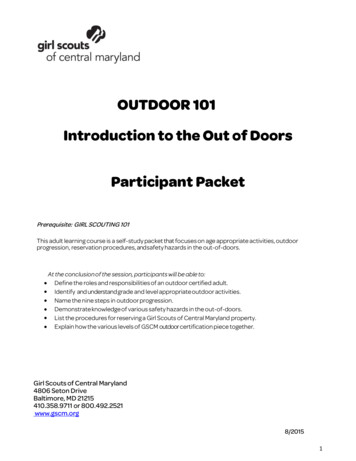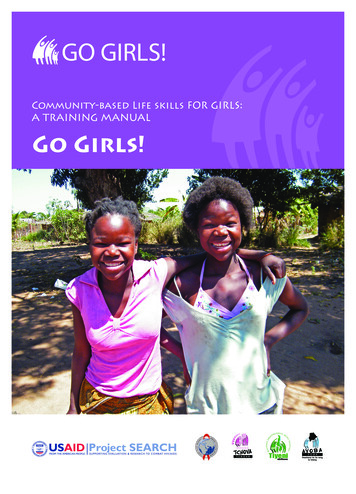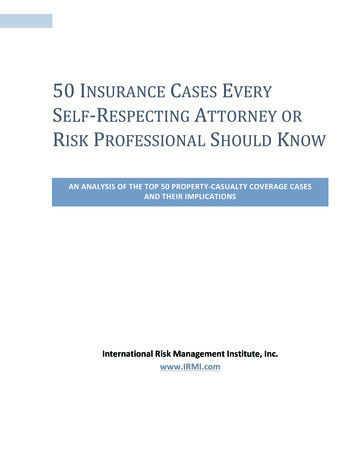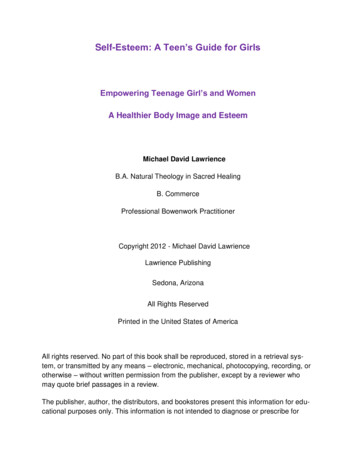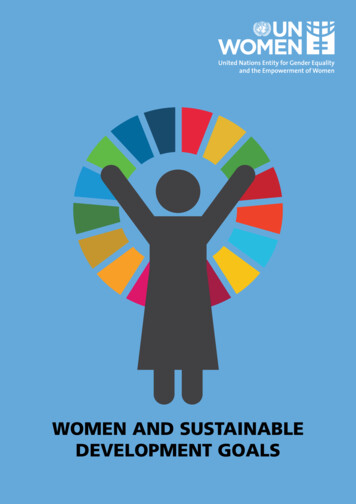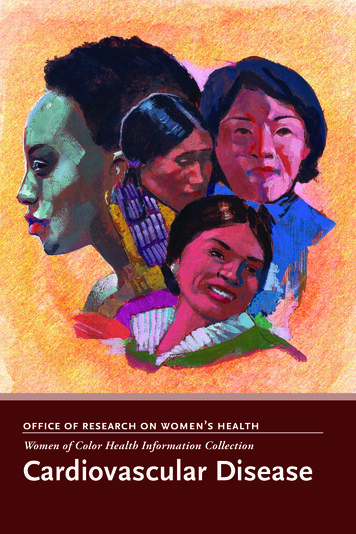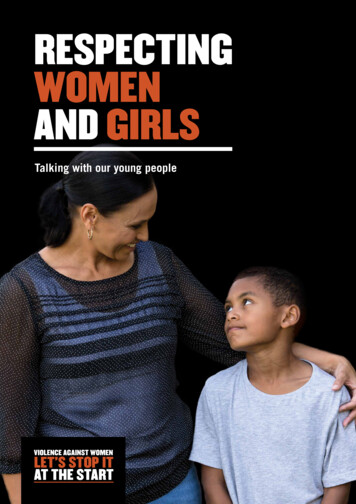
Transcription
RESPECTINGWOMENAND GIRLSTalking with our young people
ADULTS HAVE THE GREATESTPOTENTIAL INFLUENCE TO SHAPEPOSITIVE ATTITUDES AMONGYOUNG PEOPLE.RESPECTING WOMEN AND GIRLS2
INTRODUCTIONTHE ISSUE: VIOLENCE AGAINST WOMENViolence against women is wrong.We know that:›› Indigenous women and girls are 34 times more likely to behospitalised due to family violence related assaults than otherAustralian women and girls. 1›› Indigenous women in remote and regional areas experiencerates of family violence up to 45 times higher than otherwomen. 2TOGETHER WE CAN HELP STOP THE CYCLEOF VIOLENCE AGAINST WOMENAs parents, family members, teachers, coaches, employers,Elders and role models, we can have a positive influence onyoung people, we can teach them about acceptable behavioursand respect for women and girls, right from the start.We can be more aware of the excuses we make, and how theycan impact on our young people.We can start talking about respect with boys and girls.We can ‘stop it at the start’ and help prevent violence againstwomen and girls.THIS CYCLE OF VIOLENCE STARTS WITHDISRESPECTNot all disrespect towards women ends in violence. But allviolence against women starts with disrespectful behaviour.Disrespect starts with what we see, the stories we hear and whatwe learn from adults when we are young.Without realising it, we can sometimes say and do thingsthat make young people think disrespectful and aggressivebehaviours are ok.Over time, our young people start to believe that disrespect isnormal.References:1 KPMG 2009, The Cost of Violence against Women and their Children, SafetyTaskforce, Department of Families, Housing, Community Services and IndigenousAffairs, Australian Government.2 Lievore, D 2003, Non-reporting and hidden recording of sexual assault:an international literature review, Australian Institute of Criminology for theCommonwealth Office on the Status of Women, Canberra.RESPECTING WOMEN AND GIRLS3
OUR YOUNG PEOPLE LEARN FROM US,WHAT ARE WE TEACHING THEM?We all want the best for our young people. We wantthem to be the best they can be, to be proud of whothey are, and have healthy relationships with others.We want our young males to respect women andgirls, and to respect themselves.Sometimes, without knowing it, we can make excuses thatcause our young people to think that disrespect and aggressionare normal.To stop violence towards women and girls we must understandhow it is linked to disrespect and the view that women/girls arenot equal to men/boys.WHAT IS DISRESPECTFUL BEHAVIOUR?Examples are:›› putting pressure on someone to do something they are notcomfortable with›› using power to control, abuse or bully someone›› treating someone as though they are not as important as you›› treating someone differently because they are different fromyou in some way›› dismissing what someone believes, or how they feel aboutsomething.We can help reduce disrespect against women and girls in ourcommunity.To do this, we need to be more aware of the excuses we makeand recognise how our own behaviour and attitudes can makedisrespect for women and girls seem as though it is normal inour communities.Then, we can start talking with our young people about respect.Some talks are easy to have, and some are a bit harder, andsometimes we don’t even know where to start.This guide is a practical tool to help you talk confidently andopenly with young people about respectful relationships.We can all be part of the solution to help prevent violenceagainst women in our communities. Let’s stop it at the start.It’s our responsibility toshow and teach our youngpeople that disrespect isnot normal.Author, mother and survivor of domestic violence,Lani BrennanRESPECTING WOMEN AND GIRLS4
WHAT HAS DISRESPECT GOT TO DO WITH VIOLENCEAGAINST WOMEN AND GIRLS?Violence against women and girls starts withdisrespect. The excuses we make as adults allowdisrespect to grow.These attitudes then become a normal part of growing up.We can be part of the solution to make sure our young menrespect women and girls. Teaching young men about respectwill help make our communities stronger.Even though we strongly believe that violence against womenand girls is wrong, we don’t always know how or when to changethings. We aren’t always aware of how we allow boys to developdisrespectful attitudes towards women. We raise young girlsto think disrespect is normal when we play down disrespectfulbehaviour.young people don’t thinkit’s serious when guys insultor verbally harass girlsin the streetyoung people believe thereare times when women bearsome responsibility forsexual assaultyoung people don’t think it’sserious if a guy who’s normallygentle sometimes slaps hisgirlfriend when he’s drunkand they’re arguingyoung men believe that girlslike guys who are in chargeof the relationshipStatistics:TNS, Reducing violence against women and their children campaign research, 2015Our Watch, The Line campaign research, 2015VicHealth, National Community Attitudes Towards Violence Against Women Survey, 2013RESPECTING WOMEN AND GIRLS5
LET’S STOP THINKING DISRESPECT IS OKWhen we talk to our young people about disrespectit’s important to be clear about what is ok and what’snot.It can be hard to question our own behaviours and attitudestowards women and girls. But if we don’t challenge our thoughtsand actions, we might be excusing disrespect, aggression andpotentially violence without knowing it.These include:›› not taking the behaviour seriously›› accepting aggression as just part of being a boy›› blaming girls.Our young people can misunderstand what we say and see itas an excuse or permission to be disrespectful. Are we makingexcuses for disrespectful and aggressive behaviour?RESPECTING WOMEN AND GIRLS6
HOW TO RECOGNISE OUR MOSTCOMMON EXCUSES1. NOT TAKING THE BEHAVIOUR SERIOUSLY3. BLAMING GIRLSThis is when we don’t take disrespectful or aggressive actionsseriously.Sometimes we shift the blame when a male is disrespectful oraggressive towards a female. This can send the wrong messagethat she must have done something to cause the behaviour andthe situation.HAVE YOU EVER THOUGHT OR SAID “Just ignore it, it wasn’t that bad”HAVE YOU EVER THOUGHT OR SAID “Did you say something he didn’t like?”“He just did it because he likes you”Responding in this way teaches our kids and young people thatthis behaviour is ok and even normal, and that boys are justhaving a ‘bit of fun’ with girls.2. ACCEPTING AGGRESSION AS JUST PART OFBEING A BOY“It takes two to have a fight”Responding in this way teaches our young boys that it is notalways their fault if they are disrespectful or aggressive, andteaches our young girls to question if they are to blame.When we take the boy’s side, it can send the wrong messagethat boys and men find it harder to control themselves or theymust have had a reason for their behaviour.HAVE YOU EVER THOUGHT OR SAID “He was having a bad day; it’s tough being a boy”“Boys will be boys”Responding in this way teaches our kids and young people thatdisrespectful or aggressive behaviour is ok among boys.RESPECTING WOMEN AND GIRLS7
THINKING ABOUT THE CONVERSATIONThe opportunity to have important talks with your kidsor other young people may happen at any time, so it’sgood to be ready for it.if his friends aren’t. If you have a daughter, you can encourageher not to keep things to herself or feel that it’s her fault when aboy teases her or puts her down.By thinking through what you believe, what you might sayand how you can have positive conversations with your son ordaughter, you will feel more confident to make the most of eachopportunity.LISTEN TO THEMBE READY TO TALKIn the car, playing footy in the backyard, fishing, shopping orwatching television – be prepared to talk when you see or hearsomething you’re not comfortable with, when your child asksa question or when they just want to have a yarn with you. Forexample, think about how your daughter might respond to aboy’s insult or teasing, or what your son could do if one of hisfriends showed him a photo of a girl without her permission.Take a look at the Respect Checklist for more topic ideas.It’s important to listen to young people, as much as it is to talkwith them. Listening will tell you about the attitudes they aregrowing up with and give you the opportunity to talk to themabout any issues or challenges they are facing.TEACH BY EXAMPLEYoung people learn from their parents and other adults. That’swhy it’s important to think about how you show respect toothers, and how you can be a positive role model. What yousay and do influences their attitudes and behaviours. No oneexpects you to be perfect. The important thing is to be awareof your own behaviour, be honest and consistent, so you canprovide your kids with positive examples.THINK OF EXAMPLESUsing examples based on things you have seen, heard, orexperienced yourself is a good way to help young peopleunderstand the issue. For example, if you hear a comment in anews story that a woman who was hurt by a man shouldn’t havebeen out on her own, you could use this to talk about opinionsthat women are to blame. If you come across a useful example,try to remember it so that you can bring it up later when theopportunity arises to have a talk. As before, the RespectChecklist has some other topics that could help you get started.WHEN TO GET INVOLVEDTalk through how your kids and young people might handlesuch situations themselves. If you feel you need to step in,explain this to them and do whatever you think is necessary.Even if they say they don’t want you to get involved, youngpeople who are at risk of harm need adults to step in.BE HONESTLet your kids know you haven’t got all the answers but thatyou do know it’s important to treat others with respect and thatothers respect us. Explain that we shouldn’t excuse behaviourthat is hurtful or harmful.ASK QUESTIONSAsk your kids how they feel and what they think, then you candiscuss their answers. Take the opportunity to teach themabout respectful relationships and tell them what you think.For example, you can talk to your daughters about what mighthappen if a boy was verbally aggressive towards her. Ask herhow she might feel, what she might be thinking, what she woulddo, and how she would feel about taking action.SEE IT THEIR WAYKeep in mind the influences your kids and young people alreadyhave – such as their friends and other people in the community– these influences can sometimes make it hard or confusingfor them to know how to react in different situations. You canhelp guide them by talking regularly and supporting them tofeel confident in the actions they take. For example, if you havea son you might talk to him about showing respect to girls evenIt’s about reflecting onour own behaviour andrecognising what is bestfor our children, becauseprevention is always easierthan intervention.Author, mother and survivor of domestic violence,Lani BrennanRESPECTING WOMEN AND GIRLS8
STARTING THE TALKSometimes it’s hard to start talking with young peopleabout disrespectful and aggressive behaviour.You might not want to say anything that could harm yourrelationship with them, or you might not want to feelembarrassed.You might be concerned about raising issues that will worry orscare them.Being confident is important but can sometimes be hard. Thesuggested topics below might help you begin the conversation.And remember, you don’t need to have all the answers, butthinking about the topics you want to talk about and practisingyour answers beforehand will help you when it’s time to talk.You might not want to make a situation worse, or say somethingthat could lead them to them have problems with others.SUGGESTED TOPIC AREASEXPLAINING RESPECTRESPECTFUL RELATIONSHIPS›› What respect means and why it’s important›› Treating people how you would like to be treated›› Respect in the family and community›› Not tolerating disrespect and aggressive behaviour›› Self-respect›› Apps like iMatter›› Respect between friends›› Services like Kids Helpline and 1800RESPECT.Visit respect.gov.au for more information and support.›› Respectful relationships between boys and girls.RECOGNISING DISRESPECT AND AGGRESSION›› How to know if someone is being disrespectful›› Laughing at others or putting them down›› Bullying, teasing and calling them names›› Fighting in the playground or rough behaviour on the sportsfieldGENDER EQUALITY›› How boys and girls are both good at lots of different things›› Gender stereotypes (when we expect women to behave in acertain way and men to behave in a certain way)›› Males and females in the media›› Why you are both equally ‘in charge’ of and ‘responsible for’a relationship.›› Intimidation and public harassment›› Physical violence.RESPECTING OTHER PEOPLE’S PRIVACY›› Taking photos, being photographed and sharing photos›› Giving out personal information online›› Texting or emailing rude or offensive language on yourphone. Respecting people and setting boundaries when youare using a phone or are online is important.Visit esafety.gov.au for more detail.RESPECTING WOMEN AND GIRLS9
STARTING THE TALK– CONTINUEDSUGGESTED WAYS YOU CAN START TALKINGTO YOUR KIDSRemember, you don’t have to have all the answers,but it can help to be prepared to begin to talk aboutrespect together. Here are some suggestions:Do you notice any differences between how boys and girls aretreated at school?Do you notice any differences between how boys and girlsbehave at school?Have you heard something a boy said to a girl did that youdidn’t agree with?Have you ever found it hard to talk to boys/girls? What are themain reasons?What do you think of the way the women/men behaved andwere treated in that movie? Other examples might be a TVshow or games your kids enjoy.Can you think of a time you may have treated someone withdisrespect?If one of your friends was being disrespectful to you, howwould you feel? What would you do?If one of your male friends was being disrespectful to someoneelse, how would you feel? What would you do?If one of your female friends was being treated with disrespectby a boy, how would you feel? What would you do?If you ever felt unsafe around a boy/girl? Where would you gofor help?RESPECTING WOMEN AND GIRLS10
DURING THE TALKIf you are a mum, you may wish to talk to yourdaughter. If you’re a dad, you may wish to talk to yourson or if you are on your own you may wish to haverelatives (Uncles or Aunties for example) talk to yourdaughter or son.Listen and be ready to respond.Sometimes when you’re talking with young people, you hearthings you didn’t know about them. For example, a boy mayhave picked on them, or a friend may have pressured a girl intodoing something she didn’t want to. If this happens, stay calmand keep listening so they don’t stop the talk and shut you out.TALKING TO YOUNG PEOPLE WHO DON’T WANTTO LISTEN OR DISAGREE WITH WHAT YOU’VESAIDSome young people don’t want to talk about difficult issues withadults. If this happens, there are a few things you can do to talkmore openly next time.›› Stay calm and set out the issues as you see them andencourage them to think about these issues.›› Always be open to talking about these issues and let themknow you appreciate them speaking to you.›› Discuss the difficult issues they face and let them know it canbe challenging to work out what is right.TALKING TO KIDS AND YOUNG PEOPLE WHO AREEXPERIENCING DISRESPECT OR AGGRESSION›› Talk about successes as well as hard times. Recall a time thatthey showed respect and reacted to a situation in a positiveway.Sometimes kids and young people try to play down a situation,to make out it’s not serious or blame themselves or others fortheir behaviour. They may also take someone’s side who is beingdisrespectful or aggressive.›› Let them know if they ever want to talk or if they feel unsurethey can come to you.Let them know:›› these attitudes are not ok›› everyone deserves to be treated with respect›› they are not to blame for other people’s behaviour›› they should be treated with respect.Even if they don’t agree with what you’re saying, let them knowit’s important to continue to talk about these issues.RESPECTING WOMEN AND GIRLS11
DURING THE TALK – CONTINUEDTALKING TO YOUR DAUGHTER/GRANDCHILD/NIECETALKING TO YOUR SON/GRANDCHILD/NEPHEWIf you are talking to your daughter/grandchild/nieceabout a situation where a boy has treated her withdisrespect, or has been aggressive towards her it isimportant to let her know this is not ok:If you are talking to your son/grandchild/nephew aboutbehaviour that is disrespectful or aggressive towards agirl it is important to:acknowledge how she feelsstay calm and talk in way that will help to encourage moretalks in the futureexplain that she is not to blameacknowledge that sometimes it is hard to know what to dosuggest and discuss ways she might respond to situations likethis in futureencourage her to consider the situation through someoneelse’s eyes—if one of her friends was in this situation, howwould she would react, and what would she tell her friend todo?talk to her about who and where she can go to for helphelp her to understand what she is feeling (frustration,distress, anger, embarrassment) is normalunderstand why he behaved that way but explain disrespectfulbehaviour is wrong and there are consequencesfocus on the behaviour - let him know it is not ok to behave ina way that is disrespectful or aggressive towards girls, ratherthan criticising him as a personbe a good role model and avoid threatening or aggressivebehaviourlet him know that he can choose to be respectful, and exploreways he can be more respectfulask him how he thinks the girl feels when he behaves that wayquestion if he would treat a friend that waytalk about actions that could be taken and let her know thatyou will support her when she is ready to take action.talk about how to respectfully disagreediscuss the difference between feeling angry and beingaggressivehelp him understand what he is feeling (frustration, distress,anger, embarrassment) is normalexplain that he is responsible for how he expresses hisfeelingsencourage him to be a role model and set a good example forhis friends.RESPECTING WOMEN AND GIRLS12
KEEP YARNINGThe more you talk to young people about difficultissues, the easier it becomes. Talking is also a wayto stay connected, strengthen family relationshipsand for you to lead by example.Talking can also help you ‘stay in touch’ with your kids andother young people and can help them develop respectfulrelationships as they grow up.You are their biggest influence. By speaking up when you seeor hear harmful attitudes and behaviours, you can contributeto respect for women and girls in your community, and help toprevent the cycle of violence.Making a positive changeand building more respectfulrelationships in ourcommunities starts withtalking to our children.Author, mother and survivor of domestic violence,Lani BrennanRESPECTING WOMEN AND GIRLS13
MORE INFORMATIONVisit respect.gov.auWHITE RIBBONFor more tools and resources, including:UNDERSTANDING OUR EXCUSESTHE EXCUSE INTERPRETER,to discover the hidden meanings of commonexpressions that can excuse disrespectful behaviourtowards girlsTHE RESPECT CHECKLIST,to give you a picture of what your son or daughtermight believe, and how they’re likely to react whenfaced with disrespect or aggression.On the website you’ll also find more detail about thecycle of violence against women, and links to a rangeof national, state and territory services.UNDEROUR STANDINGEXCUSESTHE EXCUSE INHow dowe knowexcusing disresp we areect? Thisguide willabout way help you learndisresp s we overlookectful behtowardsaviourwomenandgirls withoutknowing it.TERPRETERTHERESPECCHECK TLISA practicaand fam l checklist tohelp pareily members idenimportantsnttify someabout with aspects of respect to talkchildren.White Ribbon is a primary prevention campaign that aimsto prevent and reduce violence against women and girls byworking directly with men and encouraging men and boys totake positive action to create change.whiteribbon.org.auSAFE SCHOOLS HUBThe Safe Schools Hub is a one-stop shop for information andresources on safe school strategies to assist teachers and schoolleaders, students, parents, specialist professionals supportingstudents and pre-service teachers.safeschoolshub.edu.auNO MOREThe ‘No More’ campaign is a domestic violence action planprogram implemented in sporting clubs to help organise andplan individual approaches to reducing family and domesticviolence in their communities.nomore.org.auTFIND YOUR NEAREST ABORIGINAL COMMUNITYCONTROLLED HEALTH ORGANISATIONThe NACCHO App contains a geo locator, which will helpyou find the nearest Aboriginal Community Controlled HealthOrganisation in your area and provides health information onlineand telephone on a wide range of topics and where you can goto get more information or assistance should you need urgenthelp.iPhone/iPadios.giveeasy.org/nacchoTHE LINEAndroidThe Line encourages healthy and respectful relationships bychallenging and changing attitudes and behaviours that supportviolence. The Line is an initiative under the National Plan to Reduce Violence against Women and their Children 2010 - 2022and is funded by the Australian Government Department ofSocial Services. It is delivered by Our Watch.FAMILY VIOLENCE PROGRAMS ANDORGANISATIONStheline.org.auThe Line – Respect Each Other provides young Aboriginals andTorres Strait Islanders with ways to learn about healthy and respectful relationships, as well as resources for teachers, parents,relatives and other community members to help lead the waywith lessons and activities. - See more acchoThe Australian Indigenous HealthInfoNet is an innovativeInternet resource that aims to inform practice and policy inAboriginal and Torres Strait Islander health by making researchand other knowledge readily accessible. The section on FamilyViolence provides a list of current and non-current IndigenousFamily Violence programs, organisations delivering familyviolence services and their contact mily-violence/organisations
Violence against women and girls starts with disrespect. The excuses we make as adults allow disrespect to grow. Even though we strongly believe that violence against women and girls is wrong, we don’t always know how or when to change things. We aren’t always aware of how we allow boys to develo

